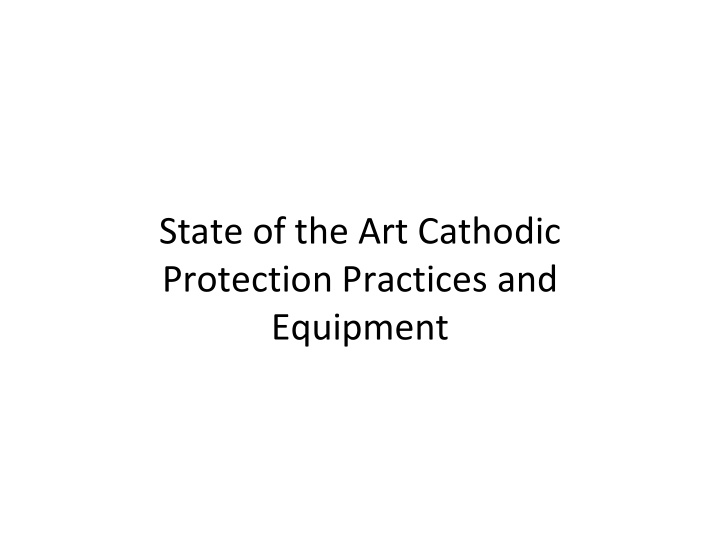



State of the Art Cathodic Protection Practices and Equipment
State of the Art Definition: The level of development (as of a device, procedure, process, technique, or science) reached at any particular time usually as a result of modern methods
Cathodic Protection � Type � Materials � Installation � Monitor / Survey Techniques
Types of Cathodic Protection Sacrificial Anode � Small Current Requirement • Well Coated Structures • Isolated Structures � Low to Medium Soil Resistivity
Types of Cathodic Protection Impressed Current � Large Current Requirement • Poorly Coated Structures • Shorted Structures � High Soil Resistivity
Sacrificial Anodes Magnesium & Zinc Typical
Sacrificial Anode Zinc Ribbon
TYPICAL SACRIFICIAL ANODE INSTALLATION SINGLE ANODE MULTIPLE ANODE GRADE GRADE PIPE ANODE ANODE ANODE ANODE PIPE AT PIPE DEPTH TO 5' TYPICAL ANODE 10'-15' MIN 5' TO 15' FOR MAGNESIUM TYPICAL 5' MIN FOR ZINC 5' MIN
Typical Sacrificial Anode Installation
Typical Sacrificial Anode Installation
Typical Sacrificial Anode Installation Ribbon Anode
Impressed Current Rectifier � Constant Voltage � Constant Current � Auto Potential � Pulse � Alternative Power � Solar � Thermo Electric � Wind � Hydro
Impressed Current Anode Graphite
Impressed Current Anode High Silicon Cast Iron
Impressed Current Anode Mixed Metal Oxide
TYPICAL IMPRESSED CURRENT ANODE INSTALLATION DISTRUBUTED PIPE ANODE RECTIFIER - + ANODE ANODE PIPE ANODE ANODE ANODE
TYPICAL IMPRESSED CURRENT ANODE INSTALLATION REMOTE RECTIFIER ANODES - + PIPE 200' TO 500' TYPICAL
TYPICAL IMPRESSED CURRENT ANODE INSTALLATION DEEP - + PIPE 50' TO 400' TYPICAL ANODE WITHIN SLURRIED BACKFILL
GRADE GRADE TO ANODE JUNCTION BOX MINIMUM 2'-0" BURIAL SURFACE CASING TO 40 FT 75' VENT PIPE SAND / BENTONITE MIXTURE ANODE LEAD WIRES / HALAR 200' ANODES 10 EACH ON 10 FT CENTERS 125' LOW RESISTANCE BACK-FILL BOTTOM FILLED SLURRIED 10"
Impressed Current Anode Installation Distributed or Remote
Impressed Current Anode Installation Deep
Storage Tank Bottom CP New Existing
Vacuum Excavation • Utility Locating • Anode Installation • Reference Cell Installation • Test Station Installation • Depth of Cover Survey • Expose Pipeline for Coating Inspection • Subsurface Utility Engineering
Vacuum Excavation Utility Locate
Vacuum Excavation Anode / Test Station Installation
Cathodic Protection Testing � Equipment � Tools � Materials � Survey Methods
C.P. TEST EQUIPMENT 0.000 HIGH INPUT IMPEDANCE DIGITAL VOLT METER 10 M OR GREATER + COPPER/COPPER SULFATE REFERENCE CELL CLEAN, FULLY CHARGED & CALIBRATED TEST WIRES WITH ALLIGATOR CLIPS SELECTION OF SHORT & LONG WITH NO SPLICES CLEAN WATER TO SATURATE THE TEST LOCATION CLEAN WATER MISC. HAND TOOLS TO MAKE MINOR REPAIRS ON-SITE
Data Collection Read Only Self Storage
Reference Cell / Electrode • Contaminated every time it gets used SATURATED COPPER SULFATE SOLUTION � Clean Regularly O-RING SEAL PURE COPPER � Check Regularly ROD ELECTRODE BODY COPPER SULFATE CRYSTALS O-RING SEAL • The “Weakest Link” in Cathodic Protection POROUS PLUG Testing
Cathodic Protection Criteria NACE SP0169 1. ‐ 850 mV with IR Drop Considered 2. ‐ 850 mV Polarized 3. 100 mV Polarization
CP Test Location / Test Station
C.P TESTING - PERMANENT REFERENCE CELL REFERENCE VOLT METER CELL TERMINAL - 0.850 V + STRUCTURE TERMINAL PERMANENT REFERENCE CELL PIPE 1. CONNECT (+) LEAD OF VOLT METER TO STRUCTURE TERMINAL 2. CONNECT (-) LEAD OF VOLT METER TO REFERENCE CELL TERMINAL 3. READ & RECORD MEASURED POTENTIAL
Permanent Reference Electrode
C.P TESTING - PORTABLE REFERENCE CELL VOLT METER VOLT METER STRUCTURE - 0.850 V - 0.850 V TERMINAL + + C.P. TEST STATION REFERENCE CELL STRUCTURE TEST WIRE PIPE PIPE 1. CONNECT (+) LEAD OF VOLT METER TO STRUCTURE TERMINAL 2. CONNECT (-) LEAD OF VOLT METER TO REFERENCE CELL TERMINAL 3. PLACE REFERENCE CELL DIRECTLY OVER OR ADJACENT TO PIPE 4. READ & RECORD MEASURED POTENTIAL
PROPER REFERENCE CELL PLACEMENT .850V 100' (TYPICAL) GRADE PIPE ANODE ANODE
Coupon Test Station • IR Free Potential Reads • No Need to Interrupt: � Rectifiers � Sacrificial Anodes � Foreign Bonds • Calculate Metal Loss
Remote Monitoring • GPS Controlled • Automatic Pipe ‐ to ‐ Soil Potential Reads • Automatic Rectifier Voltage & Amperage Reads • Alarm Notification • Interruption Capabilities • Cellular, Satellite & Radio Communication
Circuit Interruption • Rectifiers & Foreign Bonds • Sacrificial Anodes • GPS Controlled • Programmable Schedule
Fault Protection & Grounding • Solid State • Induced AC Voltage Mitigation • Stray DC Voltage Blocking • Insulated Joint Protection
Ultrasonic Thickness (UT) Gauges
Thermite Welding
Over ‐ the ‐ Line Survey Techniques
Over ‐ the ‐ Line Survey Techniques � Close Interval Survey (CIS) • Cathodic Protection Potential Profile � Pipeline Current Mapping (PCM) • Maps Cathodic Protection Current Loss due to Coating Failure or Shorted conditions � Direct Current Voltage Gradient (DCVG) � Alternating Current Voltage Gradient (ACVG) • Pinpoints Coating Defects
Recommend
More recommend